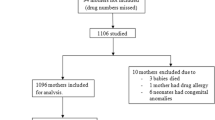Abstract
Objective
The aim of this study was to determine whether the timing of prophylactic antibiotics at cesarean delivery influences maternal and neonatal infectious morbidity.
Study design
This was a prospective, randomized trial. Four hundred patients that underwent elective cesarean section between June and December 2007 formed the study population. Eleven patients were excluded from the study because they needed transfusion during the cesarean section. The population was divided into two groups: Group A, antibiotic prophylaxis was applied to 194 women before skin incision and Group B, antibiotic prophylaxis was applied to 195 women after umbilical cord clamping. The occurrence of endomyometritis/endometritis, wound infection, febrile morbidity, total infectious morbidity, and neonatal complications were compared.
Results
There were 389 patients enrolled. No demographic differences were observed between groups. No significant difference was found between the groups for total infectious morbidity [relative risk (RR) 1.39, 95% confidence interval (CI) 0.71–2.69] and endometritis (RR 1.40, 95% CI 0.43–4.51). There was no increase in neonatal sepsis (RR 1.47, 95% CI 0.61–3.53), sepsis workup (RR 1.35, 95% CI 0.75–2.42), need for neonatal intensive care (RR 1.77, 95% CI 0.51–6.16), and intensive care stay period (P = 0.16).
Conclusions
Time of antibiotic prophylaxis application does not change maternal infectious morbidity in cesarean section deliveries. Preoperative prophylaxis application does not affect neonate morbidity rates as stated in literature.

Similar content being viewed by others
References
Gibbs RS, Hunt SE, Schwartz RW (1973) A follow-up study on prophylactic antibiotics in cesarean section. Am J Obstet Gynecol U7:419–422
Yokoe DS, Christiansen CL, Johnson R et al (2001) Epidemiology of and surveillance for postpartum infections. Emerg Infect Dis 7:837–841
Ramsey PS, White AM, Guinn DA et al (2005) Subcutaneous tissue reapproximation, alone or in combination with drain, in obese women undergoing cesarean delivery. Obstet Gynecol 105:967–973
Henderson E, Love ES (1995) Incidence of hospital-acquired infections associated with cesarean section. J Hosp Infect 29:245–255. doi:10.1016/0195-6701(95)90271-6
Smaill F, Hafmeyr GJ (2002) Antibiotic prophylaxis for cesarean cesarean section. The Cochrane Database of Systematic reviews, Issue 3. Art No: CD 000933. doi:10.1002/14651858.CD000933
Gibbs RS, St Clair PJ, Castillo MS, Castaneda YS (1981) Bacteriologic effects of antibiotic prophylaxis in high-risk cesarean section. Obstet Gynecol 57:277–282
American College of Obstetricians and Gynecologists (2003) Prophylactic antibiotics in labor and delivery:ACOGPractice Bulletin No. 47. The College, Washington, DC
Chelmov D, Ruehli MS, Huang E (2001) Prophylactic use of antibiotics for nonlaboring patients undergoing cesarean delivery with intact membranes: a meta-analysis. Am J Obstet Gynecol 184:656–661. doi:10.1067/mob.2001.111303
Rudge MV, Atallah AN, Peraçoli JC, Tristao Ada R, Mendonça Neto M (2006) Randomized controlled trial on prevention of postcesarean infection using penicillin and cephalothin in Brazil. Acta Obstet Gynecol Scand 85:945–948
Noyes N, Berkeley AS, Freedman K, Ledger W (1998) Incidence of postpartum endomyometritis following single-dose antibiotics prophylaxis with either ampicillin/sulbactam, cefazolin or cefotetan in high-risk cesarean section patients. Infect Dis Obstet Gynecol 6:220–223
Burke JF (1961) The effective period of preventive antibiotic action in experimental incisions and dermal lesions. Surgery 50:161–168
Edwards RK, Clark P, Sistrom CL, Duff P (2002) Intrapartum antibiotic prophylaxis 1: relative effects of recommended antibiotics on gramnegative pathogens. Obstet Gynecol 100:534–539. doi:10.1016/S0029-7844(02)02096-3
Thigpen B, Hood WA, Chauhan S, Bufkin L, Bofill S, Magann E, Marrison SC (2005) Timing of prophylactic antibiotic administration in the uninfected laboring gravida: a randomized clinical trial. Am J Obstet Gynecol 192:1864–1871. doi:10.1016/j.ajog.2004.12.063
Sullivan SA, Simith T, Chang E, Hulsey T, Vandorsten JP, Soper D (2007) Administration of cefazolin prior to skin incision is superior to cefazolin at cord clamping in preventing postcesarean infectious morbidity: a randomised, controlled trial. Am J Obstet Gynecol 196:455e1–455e5
Classen DC, Evans RS, Pestotnik SI, Horn SD, Menlove RL, Burke JP (1992) The timing of prophylactic administration of antibiotics and the risk of surgical wound infection. N Engl J Med 326:281–286
Fiore MT, Pearlman MD, Chapman RL, Bhatt-Mehta V, Faix RG (2001) Maternal and transplacental pharmacokinetics of cefazolin. Obstet Gynecol 8:1075–1079. doi:10.1016/S0029-7844(01)01629-5
American Society of Health-System Pharmacists (1999) ASHP therapeutic guidelines on antimicrobial prophylaxis in surgery. Am J Health Syst Pharm 56:1839–1888
Wax JR, Hersey K, Philput C, Wright MS, Nichols KV, Eggleston MK, Simith JF (1997) Single dose cefazolin prophylaxis for postcesarean infections: before and after cord clamping. J Matern Fetal Med 6:61–65. doi:10.1002/(SICI)1520-6661(199701/02)6:1<61::AID-MFM13>3.0.CO;2-P
Gordon HR, Phelps D, Blanchard K (1979) Prophylactic cesarean section antibiotics: maternal and neonatal morbidity before and after cord clamping. Obstet Gynecol 53:151
Cunningham FG, Leveno KJ, DePalma RT, Roark M, Rosenfeld CR (1983) Perioperative antimicrobials for cesarean delivery: before or after cord clamping? Obstet Gynecol 62:151
Conflict of interest statement
None.
Author information
Authors and Affiliations
Corresponding author
Rights and permissions
About this article
Cite this article
Yildirim, G., Gungorduk, K., Guven, H.Z. et al. When should we perform prophylactic antibiotics in elective cesarean cases?. Arch Gynecol Obstet 280, 13–18 (2009). https://doi.org/10.1007/s00404-008-0845-7
Received:
Accepted:
Published:
Issue Date:
DOI: https://doi.org/10.1007/s00404-008-0845-7




